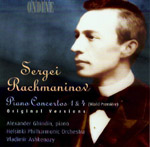Rachmaninov originally composed his Piano Concerto No. 1 while a student at the Moscow Conservatory. The work published in 1892 is not the concerto we know today, as Rachmaninov undertook wholesale revision in 1917. This recording represents his first thoughts, but unlike other “original version” recordings of accepted masterpieces of the last few years, there really can be no question that Rachmaninov, now a mature composer, knew better the second time around. The original piece actually resulted from a school assignment in which the student was to compose an original concerto using an acknowledged standard as a model. Rachmaninov chose Grieg’s A minor, and he dutifully followed his instructions. Thus, while the dramatic introduction is basically the same, the close of the exposition does not modulate unexpectedly (and brilliantly in the revision) to a new key, but instead remains where it is, drawing to a highly predictable conclusion. The same predictability (again, with respect to the Grieg) informs the development and continues throughout the slow movement and finale–both of which are charming but far less interesting than the final version.
Piano Concerto No. 4 (1927) is an altogether different case. Although it’s a polished work of Rachmaninov’s maturity, after its failed premiere the composer nonetheless subjected it to major revisions. In streamlining and refining the piece you could argue that he went too far in removing its rawness and authentic emotional expression. (Then again, the lyrical “big tune” that forms a bridge between the first movement and finale is missing from the original score.) The finale is where Rachmaninov did most of his revising and excising. You’ll notice right away the longer time needed for the main theme to assemble itself, and in place of the second subject’s marching triplets Rachmaninov introduces a cleverly disguised version of his favored Dies Irae motif. Probably most unsettling is the coda, where, missing the aforementioned “big tune” the music instead runs itself out to an enigmatic close.
The solo writing is just as formidable as in the revision, and Alexander Ghindin delivers a well-considered and executed, if not especially stirring, performance. (To his credit, Ghindin approaches the sapling First Concerto with just as much seriousness.) Vladimir Ashkenazy the pianist displays more intensity and passion in his own numerous recordings of the Rachmaninov concertos, and now as conductor he leads the Helsinki Philharmonic in probing readings of the orchestral scores, providing a fine foil for Ghindin. Ondine’s recording presents a believably natural balance between piano and orchestra.
































